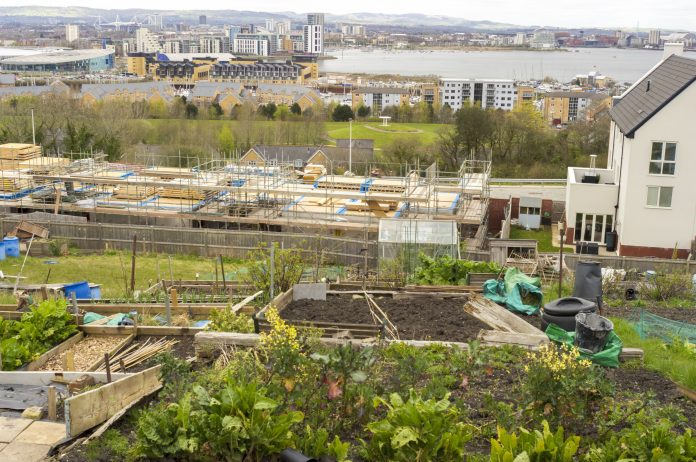Here, Rich Hyams, Director at architecture firm astudio, makes the case that despite fears of urban densification, building in our cities does not have to be incompatible with a sustainable strategy to address our housing crisis
Building in our cities to meet the acute need for affordable housing in the UK has become an area of intense debate, with many arguing that urban densification is simply incompatible with sustainability. Indeed, the potential scale of pollution and increased strain on infrastructure has led many to argue that we must go outside of our cities to develop new housing.
However, building in our cities is far from an unsustainable solution to the housing shortage and a viable long-term opportunity to utilise the space we already have. Further, with the population of urban areas forecast to grow, to ignore the importance of developing a sustainable strategy to accommodate migration to cities would be a serious miscalculation. Our cities can meet the demand for housing and to do so, we must build the foundations for a sustainable future, namely changing attitudes among city dwellers, prioritising sustainable infrastructure and developing long-term and future-proof housing strategies.
Sustainable attitudes
There is no doubt that growing populations in cities increase the pressure on local infrastructure, from parking provision, access to healthcare right through to waste management, local authorities have to work hard to meet the changing requirements and demands of larger populations. However, city dwellers themselves should also look to adapt their behaviours, from more effectively managing their waste to relying less on personal vehicles.
Taking the use of personal vehicles as an example, while behaviours are changing in favour of electric and shared-ownership models, more needs to be done to normalise, encourage and facilitate the use of sustainable transport. As we know, it’s the little changes that have the biggest impact and enabling walking, cycling and the use of public transport can reduce strain on local infrastructure, while also reducing traffic and pollution to benefit the community.
Cities are well placed to cope with new demands
Naturally, public support for increased housing in our cities will likely dissolve without the provision of sustainable infrastructure to account for larger populations. However, large cities are actually the best placed to do just this, with greater ability to enhance public services, including transport. Furthermore, urban planners can work closely with developers to strategically assess impact on hospitals, emergency services, schools and access to public transport, ensuring infrastructure adapts with demographic changes.
A good example of this is developers’ ability to target specific sites based on their Public Transport Access Level (PTAL) ratings, which assess availability, frequency and quality of public transport links in a certain area. Countryside villages, for example, are less suitable for intense development as they would require heavy investment on basic infrastructure, including roads, which can place strain on the local environment. While cities like Manchester or London, with access to multiple forms of transport, have much of this infrastructure already in place and are therefore more suitable for intense development.
Changing face of the city
Of course, we cannot deny that increased populations in our cities put greater strain on local environments, raising concerns about air quality, water pollution and rising waste.
However, the architecture and construction industry are already taking the first steps to combat this and ensure that our buildings introduce greater sustainability into our cities. At astudio, for example, we are pioneering our concept ‘reskin the city’. The concept makes the case for preserving the existing skyline, improving the efficiency and environmental impact of buildings by ‘wrapping’ facades with materials that maximise environmental advantages. This not only reduces the construction industry’s burden on resources, but also gives buildings the new ‘face’ they need to make cities more sustainable for the benefit of our environment.
One innovation that can be used to reskin the city is the use of natural substances, such as living walls. Not only is the use of plants able to absorb CO2, but it can improve building insulation and even produce biofuels. We are also undertaking research to further enhance the innovative use of natural substances to reskin cities. For instance, partnering with the likes of Brunel university, our R&D team are developing innovation in algae and bio illuminance facades to skin, power and light buildings. We believe we need to look outside of our own industry to bring benefit and change.
This doesn’t have to be distant utopia. With the right attitude, collaboration and government backing, we can build in and reskin our cities more sustainably.
Future-proofing urban construction
With pressures mounting from local and international organisations, carbon neutrality has become a priority for all industries. Indeed, the London Assembly has set a target to reach carbon neutrality by 2030. Combine this with the government targets for affordable housing and housing developers have a difficult task ahead of them. However, the cyclical nature of the UK government is stifling long-term strategic development and addressing our housing crisis requires a long-term solution.
In order to adequately respond to sustainability and housing requirements, housebuilding needs a strategy that transcends politics. The best solution to address the housing crisis for good is a plan that sits outside of government to develop our cities effectively and sustainably.
Conclusion
The UK desperately needs to resolve the housing crisis and our cities cannot be overlooked as a crucial part of the solution. Urban centres already have the infrastructure in place to deal with intense development. With greater efforts to adapt city infrastructure sustainably and for the long term, combined with a commitment by city developers and dwellers to adopt more sustainable habits, we can take a step closer to ending our housing shortage without further damaging the environment.











